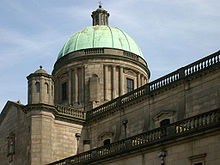John Ronald Reuel Tolkien was born on 3 January 1892 in Bloemfontein in the Orange Free State (now Free State Province in South Africa) toArthur Reuel Tolkien (1857–1896), an English bank manager, and his wife Mabel, née Suffield (1870–1904). The couple had left England when Arthur was promoted to head the Bloemfontein office of the British bank for which he worked. Tolkien had one sibling, his younger brother, Hilary Arthur Reuel, who was born on 17 February 1894.[16]
As a child, he was bitten by a large baboon spider in the garden, an event some think later echoed in his stories, although Tolkien admitted no actual memory of the event and no special hatred of spiders as an adult. In another incident, a young family servant, who thought Tolkien a beautiful child, took the baby to his kraal to show him off, returning him the next morning.[17]

When he was three, he went to England with his mother and brother on what was intended to be a lengthy family visit. His father, however, died in South Africa of rheumatic fever before he could join them.[18] This left the family without an income, so Tolkien's mother took him to live with her parents in Kings Heath,[19] Birmingham. Soon after, in 1896, they moved to Sarehole (now in Hall Green), then aWorcestershire village, later annexed to Birmingham.[20] He enjoyed exploring Sarehole Mill and Moseley Bog and the Clent, Lickey andMalvern Hills, which would later inspire scenes in his books, along with Worcestershire towns and villages such as Bromsgrove, Alcester, and Alvechurch and places such as his aunt Jane's farm of Bag End, the name of which he used in his fiction.[21]

Mabel Tolkien taught her two children at home. Ronald, as he was known in the family, was a keen pupil.[22] She taught him a great deal of botany and awakened in him the enjoyment of the look and feel of plants. Young Tolkien liked to draw landscapes and trees, but his favourite lessons were those concerning languages, and his mother taught him the rudiments of Latin very early.[23]
He could read by the age of four and could write fluently soon afterwards. His mother allowed him to read many books. He dislikedTreasure Island and The Pied Piper and thought Alice's Adventures in Wonderland by Lewis Carroll was "amusing but disturbing". He liked stories about "Red Indians" and the fantasy works by George MacDonald.[24] In addition, the "Fairy Books" of Andrew Lang were particularly important to him and their influence is apparent in some of his later writings.[25]

Mabel Tolkien was received into the Roman Catholic Church in 1900 despite vehement protests by her Baptist family,[27] which stopped all financial assistance to her. In 1904, when J.R.R. Tolkien was 12, his mother died of acute diabetes at Fern Cottage in Rednal, which she was renting. She was then about 34 years of age, about as old as a person with diabetes mellitus type 1 could live without treatment —insulin would not be discovered until two decades later. Nine years after her death, Tolkien wrote, "My own dear mother was a martyr indeed, and it is not to everybody that God grants so easy a way to his great gifts as he did to Hilary and myself, giving us a mother who killed herself with labour and trouble to ensure us keeping the faith."[28]
Prior to her death, Mabel Tolkien had assigned the guardianship of her sons to her close friend, Fr. Francis Xavier Morgan of theBirmingham Oratory, who was assigned to bring them up as good Catholics. In a 1965 letter to his son Michael, Tolkien recalled the influence of the man whom he always called "Father Francis" : "He was an upper-class Welsh-Spaniard Tory, and seemed to some just a pottering old gossip. He was—and he was not. I first learned charity and forgiveness from him; and in the light of it pierced even the 'liberal' darkness out of which I came, knowing more [i.e. Tolkien having grown up knowing more] about 'Bloody Mary' than the Mother of Jesus—who was never mentioned except as an object of wicked worship by the Romanists."[29]
After his mother's death, Tolkien grew up in the Edgbaston area of Birmingham and attended King Edward's School, Birmingham, and later St. Philip's School. In 1903, he won a Foundation Scholarship and returned to King Edward's. While a pupil there, Tolkien was one of the cadets from the school's Officers Training Corps who helped "line the route" for the 1910 coronation parade of King George V. Like the other cadets from King Edward's, Tolkien was posted just outside the gates of Buckingham Palace.[30]
In Edgbaston, Tolkien lived there in the shadow of Perrott's Folly and the Victorian tower of Edgbaston Waterworks, which may have influenced the images of the dark towers within his works.[31][32] Another strong influence was the romantic medievalist paintings ofEdward Burne-Jones and the Pre-Raphaelite Brotherhood; the Birmingham Museum and Art Gallery had a large collection of works on public display.[33]

